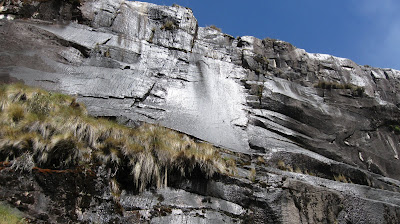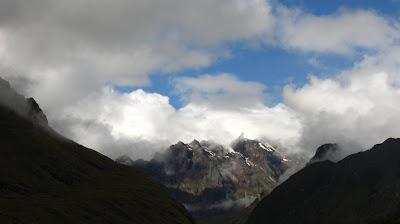Finally, and most reluctantly, I moved on from Bolivia to Peru. Soles instead of Bolivians, triangular bread instead of round buns...that´s about it for the differences... Na, just a jest, i´m not that ignant...
After an interesting stay at Isla del Sol, birthplace of the Inca, it was to be a simple 2.5 hour ride to Puno in Peru. But frankly, it never is just that simple in the land of third-world democracies. In a ride spanning 10 roadblocks, various bribe-attempts and a few thrown rocks, we spent a wonderful 6 hours waiting to reach our destination. Next to me sat 3 tear-filled Germans who paid 5 times the ticket-price and were now being badgered to cough up some more. I stepped up , given the Ïsraeli blood flowing¨ in my veins (qouth Ari Gold) and my usable spanish, and chewed out the ladron (bad guy) abit, and so the driver got the picture and ended the hustling. We reached Puno at 11 pm, found a cheap hostel and crashed. Early the next day we had our first experienced with the better, more triangular bread and headed over to the floating Islands.
up in the yacht...
The Uros Natives built these islands out of totora reeds to escape encroachment of the Incas and Aymaras, the dominant tribes of the time. They have been living on these reed-islands for centuries, replacing the éarth´every six months or so. By now, they have lost their native laguage and much of their traditions, and currently live upon the money of Gringos, but its still quite fascinating to come into contact with those who refuse to relinquish their cultural ways, even if it only consists of trappings without too much essence. On to Ariquipa...
Nlock upon Block of Totoro
12th c. version of Six Flags...
No roadblocks this time, only a lamb hanging out on the person sitting next to me, and a new phenomenon to be encountered: bus riding-salesmen. That´s correct- instead of movies or the usual Cumbia soundtrack blared over the speakers, we were treated to a constant onslaught of fiery preachers of Capitalism, hawking everything from soap, to educational cd-roms, and onto vitamin powders. And yes, they managed to sell to the people. By the end of the ride, soap was flying at me from all angles as the the bus made its kamikaze turns in the city.
Ariquipa is known as the white city, given the volcanic rock used for much of its architecture. A pretty city in the South of Peru, it is the major port to Colca Canyon, an immense natural treasure twice as deep as the Grand Canyon, at 4,160. And I was to climb it all!!!
The Canyon about half way down
We left Ariquipa at 1:30 am, on a 5 hour ride that left us at Cabanaconde. Still in that twilight between sleep and awareness, we began our trek to to the first village within the canyon. A 3 hour cascade down 1,200 meters brings us to San Juan de Chouchu. Most will settle in there for the night, but given the fact that this was an Israeli-spirited independent team of trekkers, we opted for the éxpress´trek. Continuing on, we took the harder way (not on purpose) and ended up climbing a steep, 1 hour route to Tapay. From there it would take 3 hours and two villages to reach our final destination, a hospedaje in the bottom of the valley by the name of Óasis´. It was 1:30 pm, and we were actually too tired to jump into the natural stream-water pool. After catching our breath and feasting on classic trekking food (tuna, cold cuts, cheese, rolls anyone?) we passed out at 6:30 pm, scared shitless of the trek´s second part.
Cabaconde, able to read since 1995!
We awoke at 2 am, muscles sore and head definately not ín the game´. We had over 1,100 meters to climb in what was touted as a 3 hour trek for girngos, 2 for locals. The reason for this ungodly hour simply was that the first bus to leave Cabaconde was at 7 am. This vry same bus would be the only one stopping at Cruz del Condor, where closeby is a large colony of Andean Condors. Being on an Ísraeli´trek, we did not want to spend the 35 soles paying entry for the site, especially when we can get in for free by this route. We began the ascent at 2:30 AM...it was hell. The Red Hot chili Peppers in my ears did not help. The Coca leaves barely kept me going. 20 minutes from the top, a local who couldnt have been younger than 65 finds me on my upteenth break. Asked how much longer there is, he informs me there is 20 minutes left, and demands I get a move-on with him, because it is ´getting cold´Singed by an elderly man outshining me, I did my best to keep up. The man has made this climb countless times, and hisconnection to the land was so pure and glaring, he used neither flashlight (complete darkness in the canyon) nor any other tool for finding his way up. He was actually able to walk and talk during this rediculous ascent!
Looks fearless, dont he?
We finally made it to the top, 2.5 hours later (better than gringos!) and ended up being the first ones in the plaza waiting for the bus. In the end, the bus stopped in Cruz del Condor for only 5 minutes, and inspectors were there waiting to charge us (this is what happens when Gringos find out and try to use Israeli tricks!!!) but we couldn´t care too much, given the extreme case of fatigue we were in, leading me to the following conclusion: Sure, the trek is amaizng and the sights are incredible, but I just spent 2 years walking long distances carrying heavy shit...Why do so now on my break? Sadly, as a proud member of the species...I won´t learn my lesson!
A cross and a scarecrow, or Scary Jesus for all you cynical non-believers...
p.s.
Just finished Zorba the Greek, traded it for Kiss of the Spider Woman...wish me luck!





















































